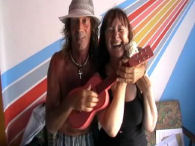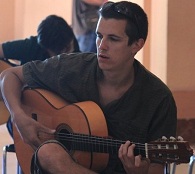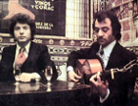Welcome to one of the most active flamenco sites on the Internet. Guests can read most posts but if you want to participate click here to register.
This site is dedicated to the memory of Paco de Lucía, Ron Mitchell, Guy Williams, Linda Elvira, Philip John Lee, Craig Eros, Ben Woods, David Serva and Tom Blackshear who went ahead of us.
We receive 12,200 visitors a month from 200 countries and 1.7 million page impressions a year. To advertise on this site please contact us.
|

|
|
What makes a palo?
|
You are logged in as Guest
|
|
Users viewing this topic: none
|
|
Login  | |
|

   
Adam
Posts: 1156
Joined: Dec. 6 2006
From: Hamilton, ON

|
 What makes a palo? What makes a palo?
|
|
|
Here's something I've been wondering about for a while now - what (in most opinions) defines un estilo flamenco? From what I can tell, some have their own compas or are always in toque libre (are there any which don't always use the same compas? What's up with rondena?). Some have their own characteristic scales/chord progressions (e.g. Tarantas, Granainas), some don't (e.g. Bulerias, Tangos). Some are only sung, some almost never. Some have their own characteristic passages/phrases (like solea or granainas), but these don't seem to be required. So what is it, then? I saw a farruca en tono de rondena recently (I think it was on a Nunez instructional tape) that didn't sound like any farruca I've ever heard before, except for the time signature, what would make it a farruca? Any help from the "experts" here would be great! 
|
|
|
|
REPORT THIS POST AS INAPPROPRIATE |
Date Aug. 29 2007 3:33:47
 |
|

   
Adam
Posts: 1156
Joined: Dec. 6 2006
From: Hamilton, ON

|
 RE: What makes a palo? (in reply to Adam) RE: What makes a palo? (in reply to Adam)
|
|
|
I'm only a newbie too, but when I said some are rarely sung, I was referring mainly to farruca, which I have heard sung, but am under the impression is usually only done with toque and baile. Could be wrong, though.
Anyway, Ricardo, there has to be more to it than the cante, otherwise a guitar solo would never have a palo in the first place, no? I'm surprised how few answers this thread is getting...maybe no one actually really knows? 
|
|
|
|
REPORT THIS POST AS INAPPROPRIATE |
Date Aug. 29 2007 15:46:49
 |
|

   
Adam
Posts: 1156
Joined: Dec. 6 2006
From: Hamilton, ON

|
 RE: What makes a palo? (in reply to Ailsa) RE: What makes a palo? (in reply to Ailsa)
|
|
|
For one thing, I remember Robin Totton saying in his book that it's usually not sung since the traditional letras are too whimsical, or something to that extent, but then again, I also was under the impression that it's almost exclusively a male dance and here you are dancing it, so maybe I should just accept that I know nothing about Farruca   Oh, one of my favorite farrucas is one I heard in Granada, too, at the Chumbera. Cantaor was named Alfredo, I think, he did a great job. Oh, one of my favorite farrucas is one I heard in Granada, too, at the Chumbera. Cantaor was named Alfredo, I think, he did a great job.
|
|
|
|
REPORT THIS POST AS INAPPROPRIATE |
Date Aug. 29 2007 16:16:07
 |
|
Guest

|
 RE: What makes a palo? (in reply to Adam) RE: What makes a palo? (in reply to Adam)
|
|
|
Farruco is an Andaluz word for someone from Galicia. The palo originates as a Galician folk song, originally always sung with the same letras: "Una farruca en Galicia lloraba amargamente...etc". Nowadays it is more usual to try new letras. The dance developed a life of its own and its most famous exponent, though not its inventor was the great Antonio Gades. In one of his films (Carmen, I think) he dances it alone, without cante or guitar.
Sean
|
|
|
|
REPORT THIS POST AS INAPPROPRIATE |
Date Aug. 29 2007 18:23:05
 |
|

   
Ricardo
Posts: 14862
Joined: Dec. 14 2004
From: Washington DC

|
 RE: What makes a palo? (in reply to Adam) RE: What makes a palo? (in reply to Adam)
|
|
|
quote:
Anyway, Ricardo, there has to be more to it than the cante, otherwise a guitar solo would never have a palo in the first place, no?
It is ok to do a solo for whatever palo, be it dance or guitar, but you must understand that that solo is based somehow on the cante. For example, you can play the same falsetas for Alegrias as Romeras when accompanying, but if you did a guitar solo and wanted to call it Romeras, then you must do something melodically that is a direct nod to the cante melody of Romeras. Otherwise you can just call your solo "Cantiñas" or "Alegrias".
A while back someone asked about why the "tientos" on Paco's latest was a tientos since it sounded like some modern rumba. Then someone pointed out the very first falseta paco plays is the melody line for a typical Tientos. It is subtle, but important to understand that the form or "palo" is defined by the cante, that being the melody, rhythm and harmony if there is any.
So some forms are commonly danced solo, Farruca, Martinete, even I have seen siguiriyas on Spanish TV with only guitar falsetas accompanyment. But does not take away from the fact the solos are based on cante forms.
Two exceptions noted above. "Zapateado" is a form for baile or guitar that is based on the Tanguillo rhythm. So like the instrumental music that goes to the footwork of Tanguillo (a song from cadiz that is sung). Likewise, an escobilla has a music form all its own based on the rhythm of the baile. I would put Zapateado and escobilla into the same category, meaning they are not palos on their own. The are part of a bigger umbrella that is the "palo". Notice on Vicente's 2nd album he has Tanguillo track 6 then Zapateado track 7. Important distinction in the rhythm, though the two forms are related. And he has made is own kind of "cante" to go with Zapateado that is not traditional by any stretch. But that is the artistic liscense of modern guitarists making innovative new recordings.
OK the other was "Rondeñas" for guitar solo, which has nada to do with the original cante, but is based on the literal song TITLE for Ramon Montoya's famous composition. So that is really the only "palo" for guitar, and it really nothing more than a special tuning, key, and overall "vibe". Of course modern players again try to use this "vibe" to accompany cante, and it could be any cante in phrygian. You can accompany por solea or fandango, bulerias, etc in this tuning/key, but the form is defined once again by the cante, not the guitar tunning. That would just be called "Solea" or "fandango", only the guitar players need to care about the tuning.
Paco and Camaron tried to make their own palo by fusing a fandango or abandolao beat with the special Rondeña tuning (Canastera). Sort of like bringing the old cante Rondena and the separate guitar form back together. It never really became a separate palo IMO, just a special song that others interpret exactly the same as they did.
Ricardo
|
|
|
|
REPORT THIS POST AS INAPPROPRIATE |
Date Aug. 29 2007 18:55:31
 |
|
 New Messages New Messages |
 No New Messages No New Messages |
 Hot Topic w/ New Messages Hot Topic w/ New Messages |
 Hot Topic w/o New Messages Hot Topic w/o New Messages |
 Locked w/ New Messages Locked w/ New Messages |
 Locked w/o New Messages Locked w/o New Messages |
|
 Post New Thread
Post New Thread
 Reply to Message
Reply to Message
 Post New Poll
Post New Poll
 Submit Vote
Submit Vote
 Delete My Own Post
Delete My Own Post
 Delete My Own Thread
Delete My Own Thread
 Rate Posts
Rate Posts
|
|
|
Forum Software powered by ASP Playground Advanced Edition 2.0.5
Copyright © 2000 - 2003 ASPPlayground.NET |
0.0625 secs.
|


 Printable Version
Printable Version

















 New Messages
New Messages No New Messages
No New Messages Hot Topic w/ New Messages
Hot Topic w/ New Messages Hot Topic w/o New Messages
Hot Topic w/o New Messages Locked w/ New Messages
Locked w/ New Messages Locked w/o New Messages
Locked w/o New Messages Post New Thread
Post New Thread